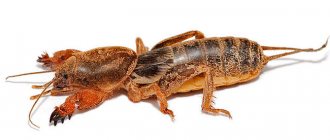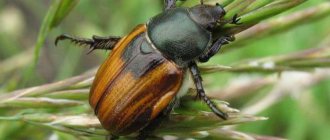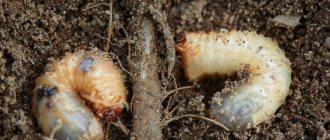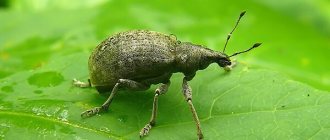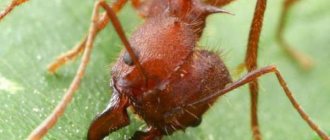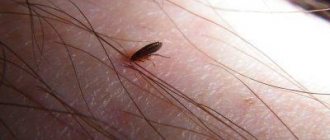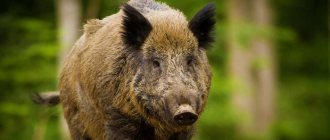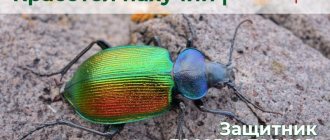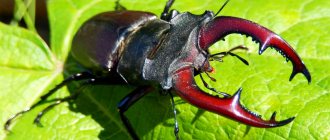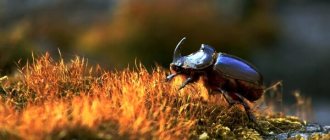- Wild animals
- >>
- Insects
The Colorado potato beetle (Leptinotarsa decemlineata) is an insect belonging to the order Coleoptera and the family of leaf beetles, belongs to the genus Leptinotarsa and is its only representative.
As it turned out, the homeland of this insect is the northeast of Mexico, from where it gradually penetrated into neighboring territories, including the United States, where it quickly adapted to climatic conditions. Over the course of a century and a half, the Colorado potato beetle has spread literally throughout the world and has become the scourge of all potato growers.
What does the Colorado potato beetle, its eggs and larvae look like?
The Colorado potato beetle has characteristic external features. It is almost impossible to confuse it with other parasitic beetles. Depending on the degree of development, the color of the insect is:
- Adults have light elytra with ten black stripes. The body shape is oval, convex, shiny. 8-12 mm long, 6-7 mm wide. The color of the Colorado potato beetle varies from yellow-red to reddish-orange. The antennae are 12-segmented, starting from the base, their thickness gradually increases. The first six segments are yellow, while the others are black. The black legs have elongated, tenacious claws, allowing the pest to migrate unhindered from one bush to another.
- The body of grown larvae is fleshy, sticky to the touch, convex on the outside, swollen in the middle, and flat on the bottom. Color – red-red or brick. The shape is worm-shaped, with sparse bristles on the sides. On the lateral parts of the body there are black spots arranged in two rows. Their length is 15 mm. When the larva is crushed, a bright yellow liquid with an unpleasant odor is released.
- Younger larvae are smaller and yellowish in color. Under favorable weather conditions, when the air temperature is at around +12 degrees, their growth and development proceeds at a rapid pace. In just a couple of weeks, they are able to eat all the green mass on potato bushes, leaving only the stems.
- Insect eggs are bright yellow in color. The surface is shiny, the shape is elongated-oval. They can be from 0.8 to 1.4 mm in length.
Based on these above-mentioned signs, even a novice gardener can identify the Colorado potato beetle by its appearance.
False pests
It happens that small beetles similar to Colorado beetles appear on the site. There are several differences between them:
- The length of the false Colorado potato beetle is only 8 mm.
- On the wings there are stripes not only black, but also white.
- The legs of this beetle are black, and the abdomen is brown.
The false Colorado potato beetle not only looks different from the real one, but also feeds differently. It will not harm agricultural crops; it is only attracted to weeds.
Origin and distribution
The first to identify and give a detailed description of the Colorado potato beetle was an entomologist and naturalist from the USA, Thomas Seyem (1824). The specimens were collected from the horned nightshade (Solanum rostratum), which grows in the Rocky Mountains. This species was identified as Chrysomela.
In 1858, it was assigned to the American genus Doryphorini by the German entomologist Christian Wilhelm Souffrian. The basis was a large number of similar features.
In 1865, the Colorado potato beetle from this category fell into the genus Leptinotarsa, where it remains to this day. The work was carried out by the popular Swedish researcher Stahl. But in some works, mainly by American entomologists, this species of beetle was called Doryphora decemlineata (late 19th century).
The potato (Colorado) beetle, belonging to the family of leaf beetles (Chrysomelidae), a subfamily of true leaf beetles (Chrysomelinae), gradually entered Europe through the holds of sea vessels transporting potatoes. Already in 1876, this pest was identified in Leipzig, and 30 years later - throughout Western Europe. The exception was Great Britain.
Until 1918, the population of the Colorado potato beetle was contained, but when it settled in Bordeaux (a region of France), where conditions were most favorable for it, breeding centers could not be contained. The insect spread quite actively throughout Western Europe.
In 1940, the potato beetle appeared in the USSR, and 15 years later - in the west of the Ukrainian SSR (Ukraine) and the BSSR (Belarus). In 1975, an insect dangerous for nightshade crops was already in the Urals. Such a rapid migration of the pest was provoked by a long dry period. It was he who became the reason for the delivery of feed to livestock from the territory of Ukraine. In 2000, the beetle ended up in the Primorsky Territory.
If we look at the geographical distribution, the voracious insect is found throughout the European part of Russia - from the Baltic states to the Black Sea coast. It lives in Western Europe, with the exception of England and the Scandinavian Peninsula. The pest attacks agriculture in Central and North America.
What does the Colorado potato beetle eat?
The basis of the diet of the pest, both adults and larvae, is the above-ground part of the bush. The Colorado potato beetle affects:
- potato;
- eggplant;
- tomatoes;
- Bell pepper;
- tobacco;
- physalis;
- petunia
The insect can also eat wild plants of the Solanaceae family. His favorite foods are potato bushes and eggplants. Considering the high degree of voraciousness of Colorado potato beetles, practically nothing remains of the plant after them. They eat stems, leaves, fruits, and tubers. When going out in search of food, the pest is able to travel dozens of kilometers. The pest has one feature - the ability to withstand hunger for 1.5-2 months. During this period, he hibernates.
Considering that the insect feeds on leaves and shoots of plants from the Solanaceae family, its body contains a high concentration of a toxic substance - solanine. Due to this, the beetle has very few natural enemies. It is of no value to birds and animals due to its toxicity.
Where does it live, how long does it live?
According to entomologists, the average lifespan of parasites is about one year. But it is worth noting that there are also more hardy members of the family that can easily endure winter cold, and for several years in a row. This is accomplished through diapause (hibernation), which is why for them, even 3 years of age is not the limit.
Speaking of the warm season, the insect lives above the ground, on top of plants, which serve as a source of food for them. In the autumn and winter, they wait for warmth; at the end of warm days, they burrow into the soil (to a depth of 0.5 meters) - there they calmly tolerate freezing to 10 degrees below zero.
With the onset of spring and the soil warming up to 13 degrees and above, they crawl out of the soil and begin searching for food, as well as a mate to continue the race. This process is not particularly widespread and can last for 2-2.5 months, which complicates the process of controlling parasites for gardeners.
Although the habitat of potato pests has increased thousands of times over the course of their existence, there are places on Earth where they have not yet been even noticed and are not aware of their danger. Among such countries are Sweden, Denmark, Ireland, Norway, Morocco, Tunisia, Israel, Algeria, Japan.
Life cycle and reproduction of Colorado potato beetles
Only adult individuals go to winter, and in the fall they burrow into the ground to a depth of 0.2-0.5 m. With the arrival of warmth, insects crawl to the surface of the earth, where they look for food in the form of potato sprouts. 3-5 days after the pest emerges from the soil, the mating process begins.
An interesting fact is that the fertilization process can occur not only in spring, but also in autumn. In this case, egg laying begins immediately upon the onset of favorable weather conditions. Females choose the reverse side of leaf blades, where they lay their offspring in groups of 28-30 eggs. One individual can lay up to 80 eggs per day. Throughout the summer period, the productivity of one female varies between 900-1600 eggs, this figure reaches up to 2000 eggs.
The larvae emerge from the eggs after 5-17 days. Before the appearance of the pupa, the final stage of development of the pest, there are 4 stages:
- The first instar larvae eat exclusively the softest part of the leaf from below. They are found on young tender leaves located at the very top of the bush.
- The second instar larvae gnaw out all the flesh, leaving only the thick middle veins.
- Larvae of the third and fourth instars feed quite intensively, attacking plants growing nearby.
After 2-3 weeks, the fourth instar larvae go into the ground to pupate. Often the depth to which they burrow is no more than 10 cm. The appearance of the pupa can be observed after 10-20 days, here everything depends on the temperature of the earth. Adult beetles either “emerge” or enter diapause until the next season. In case of danger, they fall to the ground as if dead.
Features of wintering
When pupating in autumn, the Colorado potato beetle overwinters in the ground, emerging to the surface. Adults can withstand temperatures down to -9 °C. If the soil is sandy, their lying depth reaches up to half a meter. In winter, Colorado potato beetles sleep for a long time; some individuals die if the frost is very severe. The female tolerates wintering worse if she has already laid eggs, since she lacks fat reserves. In spring and summer they appear on the soil surface, where their transformation occurs. They begin to wake up when the temperature of the earth warms up to 14°C and the air to 15°C.
In hot weather and during dry periods, Colorado potato beetles often go dormant. They can sleep for almost a month, after which their life is revived again and they can reproduce.
Important!
The effective time to combat Colorado potato beetles is the first and second stages of its development. This is due to the fact that the pupa and adult are not so susceptible to the effects of chemicals.
Natural enemies
The potato beetle is most afraid of the predatory bugs Perillus bioculatus and Podisus maculiventris. These are its main enemies, who love to feast on insect eggs and larvae. Dorifophagous flies, which lay their offspring in the body of the beetle, are also dangerous for the pest. They are common in countries with warm and mild climates; they are not found in Europe and Asia. Ladybugs, ground beetles, lacewing beetles and grasshoppers can also prey on the eggs and larvae of the Colorado potato beetle.
There is an opinion among scientists that for the effective destruction of the pest of all nightshades, its natural enemies, and not agrochemicals, are best suited. This method is not only environmentally friendly, but also more promising.
Among the natural enemies of the potato beetle, in addition to bedbugs and flies, there are also pheasants, turkeys, guinea fowl, and partridges. For poultry, not only the adult generation is of interest, but also their larvae.
Reasons for the appearance of the Colorado potato beetle
The Colorado potato beetle settles in a garden or field if:
- The land was not cultivated before planting. Considering that the pest can remain in the ground for several years, in the absence of special means, it will always affect plantings.
- No measures were taken to combat weeds. It is in it that the insect lays its offspring.
- Potatoes were planted in close proximity to tomatoes and eggplants. The best neighbors for potatoes are aromatic herbs (calendula, mint), as well as horseradish.
- There is a natural migration of the beetle from one area to another.
To reduce the likelihood of the Colorado potato beetle appearing in the garden, it is worth planting varieties with a sufficient degree of resistance to the beetle.
What birds is he afraid of?
Do guinea fowl eat Colorado potato beetles? Methods of combating the Colorado potato beetle are extremely diverse. For example, the striped pest can be partially exterminated with the help of birds : pheasants like its larvae. Indeed, guinea fowl eat Colorado potato beetles.
Grown-up individuals are eaten by turkeys , but this is not inherent in nature, therefore, from a very young age, breeders must accustom the bird to this.
The bird that eats the Colorado potato beetle is the turkey. the farmer adds a little crushed pest to its food , increasing the amount each time. You can also place the insects inside a piece of bread and let the turkey taste it.
A bird that itself expresses a desire to eat a beetle is called a guinea fowl. She likes Colorado pests because their bodies are rich in protein, and the bird cannot live without it .
You should not allow insects into the field so that the guinea fowl can find them on its own. It is better to add bugs to her food, as is done when training turkeys.
In parallel with this, it is sometimes necessary to slip beetles to the bird separately, without mixing them with other food - this will allow the guinea fowl to recognize the true taste of the pest and remember it.
When the animal is convinced that the Colorado potato beetle is a delicacy, it can be allowed to “free swim,” that is, in a field planted with potatoes. The guinea fowl itself will collect insects from the leaves , and at the same time peck the larvae and eggs.
One guinea fowl will not be enough for one garden. It is advisable to have 3-4 birds. It is best to release them to feed on their own when the pests have just appeared. This will guarantee their complete extermination.
See also the material on how to get rid of the Colorado potato beetle using vinegar.
So, we have found out the features of the life of the Colorado potato beetle.
Let's note the most important points:
- the pest has an addiction to potatoes and eats its leaves;
- the Colorado potato beetle can easily be confused with the false beetle, which does not pose a threat to vegetables;
- the insect lays eggs mainly in the spring and selects potato leaves for this;
- the enemy of the Colorado potato beetle is the guinea fowl bird;
- beetles do not tolerate odors, especially rotten onions.
See also the material about the drug Commander for the Colorado potato beetle.
Damage caused
Unlike adult specimens, their larvae are the most gluttonous. Under comfortable weather conditions, their development proceeds at a rapid pace. Moreover, the number of eggs increases tens of times.
If you do not fight the pest, then in just a few days the potato bushes may be left without green mass. As a result, tubers do not form and the plant dies. In order to grow not only a quantitative, but also a high-quality crop, one should not neglect methods of prevention and timely treatment of bushes in case of damage to them by parasitic individuals.
Ways to get rid of the Colorado potato beetle
You can fight the Colorado potato beetle in different ways. But at the initial stage of damage, it is better to use safer and environmentally friendly drugs. But in case of serious foci of infection, it is important to use chemicals.
Chemical
The market offers a huge range of agrochemicals that allow you to quickly and effectively destroy the potato beetle. But they must be used in strict accordance with the manufacturer's instructions. Do not neglect precautions and exceed the recommended dosage.
It is optimal to process plants in the morning or evening hours. If you use a solution of chemicals in the afternoon, when the peak of sun activity is very high, you can provoke the spread of toxic substances. It is not advisable to constantly use the same products; the pest often develops an addiction to them. In the fight against pests, systemic drugs have proven themselves to be effective; after entering the gastrointestinal tract, they cause the death of the insect.
Among the chemicals that are highly effective against the Colorado potato beetle are:
- Inta-Vir;
- Decis;
- Prestige;
- Fitoverm;
- Karate;
- Tanrek;
- Colorado;
- Bushido;
- Sonnet;
- Regent;
- Aktar.
Mechanical
This method of getting rid of the Nightshade pest will be effective only if its population is small. This includes not only collecting adults and their larvae, but also grinding the laid eggs. It is optimal to go out to inspect young bushes on sunny days, when the temperature is above +14 °C. This is ideal weather for the Colorado potato beetle; it is quite active and easily visible. It is necessary to look not only at the outside, but also at the inside of the leaf; there may be yellow/orange eggs on it.
In order not to miss the moment of the Colorado potato beetle spreading on the site, it is necessary to regularly inspect the plantings and the soil under them. Alternatively, the pest can be collected manually by placing it in a container with a concentrated solution of salt, kerosene, or wood ash.
Agrotechnical
The use of agrotechnical techniques can improve both the growth and development of bushes, and increase their immunity to diseases and pests. The weakest plants are always at risk. To save the future harvest and prevent the appearance of parasitic individuals on the site, you need to adhere to the following recommendations:
- Choose potato varieties that are resistant to the Colorado potato beetle for planting.
- Use exclusively healthy seed material, without signs of rot or disease.
- Follow the rules of crop rotation. By alternating planting, it is possible to stabilize and accumulate organic matter in the soil, as well as to achieve decompaction of the soil and subsurface horizon.
- Destroy weeds.
- Distribute areas away from pumpkin and nightshade crops;
- Do deep digging of the soil in the fall.
- Early ripening varieties should be planted earlier.
- When hilling the sprouts, cover the lower tier of leaves higher.
- Regularly loosen the soil to reduce the population of pupated pests.
- Remove from the site all plant waste remaining after harvesting.
- Mulch the soil with straw and pine needles.
Biological
Unlike insecticides, biological methods are completely safe for both the plant itself and the environment. The harvested crop will be absolutely safe for human health. For the Colorado potato beetle, the most difficult conditions for its existence are created. Protective plants such as marigolds, spring garlic, bush beans, and broad beans are planted between the rows.
In the fight against the Colorado potato beetle they use:
- Bitoxibacillin. The working solution is used to spray bushes in the morning or evening. Repeated manipulation is done after a week. Optimal temperature range +15…+32°C. The main thing is that the air temperature is not below +12 °C. After penetration of the bacteria Bacillus thuringiensis var. Thuringiensis inside the Colorado potato beetle, its ability to fertility and nutrition is lost, lethargy and inactivity appear. An insect with an affected digestive tract dies after 2-4 days. The effect of protein crystals is observed only in an acidic environment with values of 9.5.
- Fitoverm. This is one of the most popular remedies against potato beetles. It is also used by spraying as insects spread during the period of plant growth and development. But it is not always possible to get rid of the pest in one treatment; 2-3 procedures will be required. Considering that the effect of the drug directly depends on external factors, it should be used in clear weather. The interval between treatments is 3-7 days. Plants remain under its protection for 7-20 days. Once inside the insect, the drug immobilizes it and leads to death (after 3-6 days). After 8-10 hours the pest stops feeding.
- Anthonem-F. The intestinal bioinsecticide has proven itself in the fight not only against Colorado potato beetle larvae, but also against wireworms, mole crickets, and thrips larvae/pupae. This concentrate of live nematodes infects insects completely, showing eradicating results of disinfestation. The product is absolutely safe for humans; it is classified as toxicity class 4. One of the advantages of the drug is the long-lasting effect of use; the vital activity of nematodes remains in the soil for up to two years.
